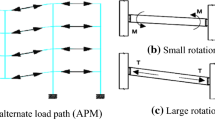Abstract
Disproportionate or progressive collapse is a phenomenon in which entire structure or large part of it collapses because of the local failure of a structure. Resistance to such progressive collapse depends on continuity between elements and ductility of the connections. The ductility of commonly used bolted end plate connections may depend on the T-stub component of the connection. The aim of this paper is to study the behaviour of T-stub components of beam to column end plate bolted connections under large deformation demands associated with column loss scenario. For this purpose, a parametric study is carried out to evaluate the ultimate strength and deformation capacity considering two parameters i.e. distance between the bolts and endplate thickness. Based on the experimental data, numerical model has been validated and employed in a parametric numerical study aimed at improving the response under large deformation demands. The study indicate significant role of bolts in development of catenary forces since the ultimate tensile capacity of T-stub after undergoing large deformation in a ductile failure mode was controlled by the failure of the bolts. Parametric study reveals much higher bolt force in comparison with displacement controlled induced axial force in the T-stub indicating failure of the bolts at much lower applied axial force.










Similar content being viewed by others
References
Abidelah, A., Bouchaïr, A., & Elddine, D. (2014). Influence of the flexural rigidity of the bolt on the behavior of the T-stub steel connection. Engineering Structures, 81, 181–194. https://doi.org/10.1016/j.engstruct.2014.09.041.
ASCE-7-05. (2006). Minimum design loads for buildings and other structures. Reston: American Society of Civil Engineers Standards ASCE/SEI 7-05.
ASCE-41-06. (2006). Seismic rehabilitation of existing buildings. Reston: ASCE/SEI Standard 41-06.
Baldassino, N., Bernardi, M., & Zandonini, R. (2017). Study of the loading rate influcence on the T-stub response. CE/Papers, 1, 182–187. https://doi.org/10.1002/cepa.582.
Barata, P., Ribeiro, J., Rigueiro, C., Santiago, A., & Rodrigues, J. P. (2014). Assessment of the T-stub joint component at ambient and elevated temperatures. Fire Safety Journal, 70, 1–13. https://doi.org/10.1016/j.firesaf.2014.08.009.
Coelho, A. M. G., Silva, L. S. D., & Bijlaard, F. S. K. (2006). Finite-element modeling of the nonlinear behavior of bolted T-stub connections. Journal of Structural Engineering, 132(6), 918–928. https://doi.org/10.1061/(asce)0733-9445(2006)132:6(918).
Dinu, F., Dubina, D., Marginean, I., Neagu, C., & Petran, I. (2015). Axial strength and deformation demands for T-stub connection components at catenary stage in the beams. In 8th international conference on behavior of steel structures in seismic areas, Shanghai, China (pp. 623–630).
Ellingwood, B. R., Smilowitz, R., Dusenberry, D. O., Duthinh, D., Lew, H. S., & Carino, N. J. (2007). Best practices for reducing the potential for progressive collapse in buildings. U.S. National Institute of Standards and Technology (NIST), NIST Interagency/Internal Report (NISTIR)—7396.
EN 1991-1-7. (2006). (English): Eurocode 1: Actions on structures—Part 1–7: General actions—Accidental actions [Authority: The European Union Per Regulation 305/2011^ Directive 98/34/EC, Directive 2004/18/EC].
EN 1993-1-8. (2005). (English): Eurocode 3: Design of steel structures—Part 1–8: Design of joints [Authority: The European Union Per Regulation 305/2011, Directive 98/34/EC, Directive 2004/18/EC].
Gong, Y. (2014). Ultimate tensile deformation and strength capacities of bolted-angle connections. Journal of Constructional Steel Research, 100, 50–59. https://doi.org/10.1016/j.jcsr.2014.04.029.
Gong, Y. (2017). Test, modeling and design of bolted-angle connections subjected to column removal. Journal of Constructional Steel Research, 139, 315–326.
GSA. (2013). Alternate path analysis & design guidelines for progressive collapse resistance. Washington: U.S. General Services Administration (GSA).
Hu, G., & Engelhardt, M. D. (2014). Experimental investigation of steel single plate beam end connections at elevated temperatures. Engineering Structures, 58, 141–151. https://doi.org/10.1016/j.engstruct.2013.09.015.
Khandelwal, K., & El-Tawil, S. (2007). Collapse behavior of steel special moment resisting frame connections. Journal of Structural Engineering, 133(5), 646–655. https://doi.org/10.1061/(asce)0733-9445(2007)133:5(646).
Kim, J., & Kim, T. (2009). Assessment of progressive collapse-resisting capacity of steel moment frames. Journal of Constructional Steel Research, 65(1), 169–179. https://doi.org/10.1016/j.jcsr.2008.03.020.
Nair, R. S. (2004). Progressive collapse basics. Modern Steel Construction, 44(3), 37–44.
UFC 4-023-03. (2009). Design of buildings to resist progressive collapse. Washington: Department of Defense/Unified Facilities Criteria (UFC).
Way, A. G. J. (2011). Structural robustness of steel framed buildings. Catalogue number P391. ISBN: 978-1-85942-198-7. https://www.steelconstruction.info/File:SCI_P391.pdf?internal_link. Accessed 25 June 2007.
Wulan, T., Wang, P., Li, Y., You, Y., & Tang, F. (2018). Numerical investigation on strength and failure modes of thread-fixed one-side bolted T-stubs under tension. Engineering Structures, 169, 15–36.
Yang, B., & Kang, H. T. (2012). Numerical analyses of steel beam-column joints subjected to catenary action. Journal of Constructional Steel Research, 70, 1–11. https://doi.org/10.1016/j.jcsr.2011.10.007.
Yang, B., & Kang, H. (2013a). Experimental tests of different types of bolted steel beam-column joints under a central-column-removal scenario. Engineering Structures, 54, 112–130. https://doi.org/10.1016/j.engstruct.2013.03.037.
Yang, B., & Kang, H. (2013b). Robustness of bolted-angle connections against progressive collapse: Mechanical modelling of bolted-angle connections under tension. Engineering Structures, 57, 153–168. https://doi.org/10.1016/j.engstruct.2013.08.041.
Yu, H., Burgess, I., Davison, J., & Plank, R. (2009). Tying capacity of web cleat connections in fire, Part 1: Test and finite element simulation. Engineering Structures, 31(3), 651–663.
Acknowledgements
Partial funding for the experimental part was provided by the Executive Agency for Higher Education, Research, Development and Innovation Funding, Romania, under Grant PCCA 55/2012 (2012–2016) and by the strategic Grant POSDRU/159/1.5/S/137070 (2014) of the Romanian Ministry of Education, co-financed by the European Social Funds—Investing in People, within the Sectorial Operational Programme Human Resources Development 2007–2013. This study was done under European Commission funding of “Sustainable Constructions under natural hazards and catastrophic events” Erasmus Mundus Master Course 520121-1-2011-1-CZ-ERA MUNDUS-EMMC.
Funding
Executive Agency for Higher Education, Research, Development and Innovation Funding, Romania (PCCA 55/2012 (2012-2016)), Professor Florea Dinu.
Author information
Authors and Affiliations
Corresponding author
Rights and permissions
About this article
Cite this article
Anwar, G.A., Dinu, F. & Ahmed, M. Numerical Study on Ultimate Deformation and Resistance Capacity of Bolted T-Stub Connection. Int J Steel Struct 19, 970–977 (2019). https://doi.org/10.1007/s13296-018-0186-8
Received:
Accepted:
Published:
Issue Date:
DOI: https://doi.org/10.1007/s13296-018-0186-8




